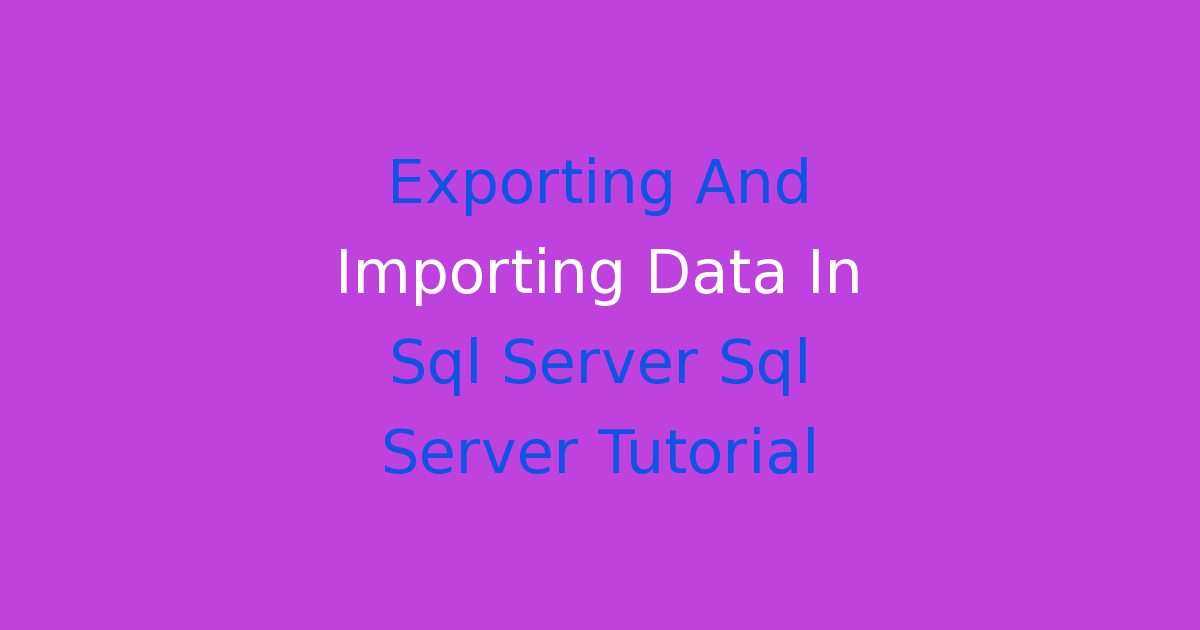In this SQL Server tutorial, we will explore the process of transferring data into and out of a SQL Server database using the Export and Import features.
Exporting and Importing Data in SQL Server – SQL Server Tutorial
Introduction
In today’s digital world, the need to export and import data in SQL Server has become increasingly important. Whether it is transferring data between servers, backing up important information, or simply migrating data to a new system, having a solid understanding of exporting and importing data in SQL Server is crucial for any aspiring engineer.
Problem Statement
The current methods of exporting and importing data in SQL Server are often time-consuming and prone to errors. Manual processes can lead to inconsistencies in data, and the lack of automation can result in inefficiencies in the workflow. Additionally, the complexity of the current system can hinder productivity and limit the ability to quickly and efficiently transfer data between systems.
Existing System
The existing system for exporting and importing data in SQL Server typically involves using tools such as the SQL Server Management Studio or BCP (Bulk Copy Program). While these tools can be effective in exporting and importing data, they often require manual intervention and lack the ability to automate the process. This can lead to errors and inconsistencies in data, as well as inefficiencies in the workflow.
Disadvantages
Some of the disadvantages of the current system for exporting and importing data in SQL Server include:
– Manual processes that are time-consuming and prone to errors
– Lack of automation and scheduling capabilities
– Complexity that hinders productivity and efficiency
– Inconsistencies in data due to manual intervention
– Limited ability to quickly transfer data between systems
Proposed System
To address these challenges, we propose a new system for exporting and importing data in SQL Server that leverages the power of automation and scheduling. By integrating tools such as SSIS (SQL Server Integration Services) and PowerShell scripting, we can streamline the process of exporting and importing data, reducing errors and inconsistencies. Additionally, by implementing a user-friendly interface, we can simplify the workflow and improve productivity.
Advantages
Some of the advantages of the proposed system for exporting and importing data in SQL Server include:
– Automation and scheduling capabilities for efficient data transfer
– Integration of tools such as SSIS and PowerShell scripting for streamlined processes
– User-friendly interface for simplified workflow
– Improved productivity and efficiency in data transfer
– Reduction of errors and inconsistencies in data
Features
The key features of the proposed system for exporting and importing data in SQL Server include:
– Automation: The system will automate the process of exporting and importing data, reducing the need for manual intervention.
– Scheduling: Users will be able to schedule data transfers at specific times, improving efficiency and workflow.
– Integration: The system will integrate tools such as SSIS and PowerShell scripting to streamline the process of exporting and importing data.
– User-friendly interface: The system will have a user-friendly interface that simplifies the workflow and improves productivity.
– Error handling: The system will have built-in error handling capabilities to reduce errors and inconsistencies in data.
Conclusion
In conclusion, the proposed system for exporting and importing data in SQL Server offers a more efficient and streamlined approach to data transfer. By leveraging automation, scheduling, and integration capabilities, the system can reduce errors and inconsistencies, improve productivity, and simplify the workflow. With a user-friendly interface and built-in error handling, the proposed system provides a comprehensive solution to the challenges of exporting and importing data in SQL Server. By implementing this system, engineers can enhance their data transfer processes and ensure the seamless transfer of information between systems.

